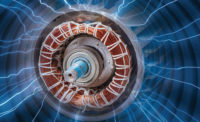Everyone who is responsible for pump maintenance has received the dreaded phone call at 4:30 p.m. on a Friday afternoon that a critical pump has a seal failure. All parties now go into crisis mode. Wouldn’t it have been nice to prevent this failure or have been alerted of its occurrence?

Normally, reactive maintenance is three- to five-times more expensive than other forms of maintenance, and, many times, it occurs in the case of a catastrophic failure or damage. Condition-based monitoring (CBM), predictive, and preventive are the other forms of maintenance. Predictive and preventive maintenance rely on fixed values and may not help address situations that cause unexpected failures due to system conditions or defective materials/workmanship. This is where CBM comes into play.
So, what is CBM? A good analogy would be that CBM is a health monitor that constantly oversees the vital signs of a person’s body and sends a report to his or her doctor when abnormal levels are reached, who, then, implements a corrective action plan. Similarly, if system performance data reaches dangerous levels, CBM will alert technicians to proactively correct a problem and allow the system to be shut down to prevent further damage. While the body cannot do this, CBM can, which helps prevent catastrophic failures and/or reduced unplanned downtime.
CBM is available in many variable-frequency drives (VFDs), but the features are not equal. Some VFDs will require various external sensors or analytical devices. Additionally, what the VFD does with this information varies widely. Some VFDs simply store a few data points on given timed intervals. Others will report the VFD information, such as voltages, frequencies, and current levels, to a supervisory control and data acquisition (SCADA) or cloud system and require that system to analyze what is happening in the process. Only a few VFDs will incorporate edge computing and machine learning to constantly predict what is happening in the VFD, and even further, in the engineer's process.
Using CBM Effectively
The vital signs of CBM with VFDs are vibration — the blood pressure — blood sugar, and cholesterol. Motor stator health is the heart and heart rate of the body. These two components provide the baseline. Vibration can identify many things, like is there an imbalanced or clogged impeller, is a bearing going bad, and are there any cavitation issues or even a misalignment. The motor stator health tells how the motor is doing and if it is beginning to short out.
Developing the baseline (load envelope) is key to CBM. There are three methods of establishing a baseline that can be utilized. The first is manual. This is where prior known values are programmed into the VFD. The second is a baseline run. This is performed during commissioning. The drive is operated through the normal speed range, where a baseline is determined. Be aware that when utilizing this method, consideration should be given to a breaking-in period, where the equipment is operated through the full speed range to establish normal operating levels. If performing a full baseline is not possible, it is recommended to perform an extended learning cycle that can last up to a few weeks or even months. The last method is online baseline, which captures baseline data during normal operation. This is useful in situations when a baseline run cannot be performed, because the application does not allow exploring the entire speed range. This online baseline should be run long enough to determine a normal baseline. This could be anywhere from a few hours to several months, depending on the system.
Once the baseline is developed, thresholds for normal, warning, and alarm levels can be established. Under normal operating conditions, nothing needs to be done, as all systems are functioning. A warning message indicates a threshold level outside the normal operating range has been reached, and the equipment should be inspected. An example of this could be a clogged impeller. If a higher level of deviation occurs, an alarm is triggered, indicating immediate action is required. Additionally, with an alarm condition, the VFD can be programmed to shut down to prevent failure of the equipment.

Filling a Critical Need
People may ask, “What are the advantages of CBM over predictive or preventive maintenance?” CBM takes a maintenance plan to the next level by providing timely information regarding performance of the system. This allows a team to study its system and find answers to the unexpected failures and can be helpful determining why critical part failures are happening prematurely. This data can be accessed locally at the drive, via the cloud, or through a local SCADA to provide immediate feedback on the condition of the system.
Mechanical seal failures are a great example of how CBM can help facility managers reduce failure and downtime. It’s estimated that 70% of all pump failures are related to mechanical seal failures. The leading culprits of seal failure are running dry, cavitation, or shaft deflection, all of which can be easily detected with CBM. Submersible sewage pumps may get clogged and trigger the vibration sensors. Before personnel can get to the site to unclog the pumps, the seals may run dry. This can require frequent seal replacement, cause extensive damage to the pumps, and result in extensive repairs and downtime costs. These clogs and seal failures could have been prevented by allowing CBM to perform a pump cleaning or de-ragging cycle that is now available on many VFDs.
VFD manufacturers are not the only ones looking at CBM. Mechanical seal manufacturers have developed a similar process that measures equipment vibration, process temperature, process pressure, and surface temperature. This information is then sent to the cloud, where it can be analyzed, provide better control of resources, and predict failures before they happen.
Submersible pump manufacturers are also doing this. They are now able to detect wear and tear on pump components and alert personnel that a problem is arising. VFD manufacturers are also looking to this for future CBM features to measure resistance in the seal cavity, indicating moisture in the mechanical seal.
By utilizing CBM in a system, engineers are able see problems as they begin to arise, plan maintenance so they can best utilize their resources in an efficient manner, shorten unplanned downtime, and help to control spare parts inventory. In the end, this helps minimize reactive maintenance cost and improve the bottom line by helping to control spare parts inventory and unexpected downtime.
Planning for Implementation
Once a team decides to utilize CBM, its members need to look at how they will record and report this data. There are various ways of doing this. Initially, one will need to determine what “level” or “type” of CBM is being utilized. If it requires the data to be sent to an additional device (cloud/SCADA/programmable logic controller [PLC]) for analysis, then how the information is used must be addressed. If a VFD provides the CBM data in real-time with information constantly available, this data could be accessed from the VFD itself, either from the display or via serial communications. The information can also be sourced via SCADA, and, from there, a user may store it in a system or send it to a cloud service. Through edge computing and machine learning, the VFD will ensure the most up-to-date, real-time, 24/7 information is readily available.
There are some CBM providers that require a cloud-based system to access the data. These types of systems typically will require a cloud subscription service, which, over time, can be quite expensive. Additionally, there may be cybersecurity issues to consider when using a third-party, cloud-based subscription service. When evaluating the type of CBM to use, look at all local resources and security needs.
Overall, a CBM system will provide more uptime, fewer unplanned outages or call-outs, and peace of mind regarding a facility’s pumping systems.





